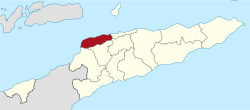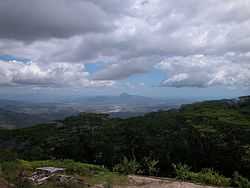Liquiçá District
| Liquiçá Likisá | ||
|---|---|---|
| District | ||
|
Fazenda Algarve in Liquiçá | ||
| ||
 Map of East Timor highlighting Liquiçá District | ||
| Coordinates: 8°41′S 125°12′E / 8.683°S 125.200°ECoordinates: 8°41′S 125°12′E / 8.683°S 125.200°E | ||
| Country |
| |
| Capital | Liquiçá | |
| Subdistricts | Bazartete, Liquiçá, Maubara | |
| Area | ||
| • Total | 549 km2 (212 sq mi) | |
| Area rank | 12th | |
| Population (2010) | ||
| • Total | 63,329 | |
| • Rank | 8th | |
| • Density | 120/km2 (300/sq mi) | |
| • Density rank | 3rd | |
| Households | ||
| • Total | 11,063 (as of 2004) | |
| • Rank | 10th | |
| Time zone | UTC+9 | |
| ISO 3166 code | TL-LI | |
Liquiçá (Tetum: Likisá) is one of the districts of East Timor. Its capital is also called Liquiçá.
Geography
Liquiçá District is situated on the northern coast of East Timor, and borders the districts of Dili (containing the national capital) to the east, Aileu to the Southeast, Ermera to the south, and Bobonaro to the southwest. To the northwest lies the Savu Sea. The district has a population of 55,058 (Census 2004) and an area of 543 square kilometers. The district is identical to the district of the same name in Portuguese Timor. Its subdistricts are Bazartete, Liquiçá and Maubara.
Widely known as a beautiful location, it has a breath-taking view of the Ombai Strait, which is most visible as you drive into Liquiçá from Dili, rounding the last mountain curve before descending into the valley. The beaches are rocky, as are most beaches on East Timor, but nonetheless beautiful. The river that flows down to the sea from the mountains is dry, except during the monsoon season. During this time, the main road washes out several times, and is repaired each time by the local population. The only downside to its beauty is the large population of mosquitoes which carry both the deadly diseases malaria and dengue fever.
In addition to the national official languages of Tetum and Portuguese, nearly all of the inhabitants of Liquiçá speak the Malayo-Polynesian language Tocodede.
History
.jpg)
While the Portuguese colonization of eastern Timor, the Maubara kingdom, in the west of today Liquiçá district, was taken by the Netherlands in 1667, while surrounding territories felt under Portuguese domination. The Maubara Dutch fortification near the beach is well preserved and still has the original cannon that once overlooked the bay. Later, Portugal negotiated with Holland in 1859 and exchanged it for Flores Island in 1861, which was occupied by the Portuguese at that time.
During the Indonesian occupation, the Indonesian government did construct many buildings in Liquiçá, but after the referendum of 1999 and during the militia`s campaign almost everything was destroyed. Most notably, many East Timorese were murdered during the Liquiçá Church Massacre of April 1999. Maubara is the location where the dreaded militia group Besi Merah Putih was first formed. In September 1999 an American police officer serving with the International Police was shot (though not fatally) by pro-Indonesian forces while the UN was evacuating Liquiçá.
From September through November 1999, life came back to Liquiçá, as UN Peace Keeping Forces from Portugal set up a base in Maubara, and the International Police set up its headquarters in downtown Liquiçá. Originally, there were 14 International Police assigned to Liquiçá, representing Sweden, Canada, Great Britain, Ghana, Malaysia, and the United States. It was in Liquiçá that the first International Police officer for the East Timor mission died, as a result of contracting dengue fever; he was from Ghana. During this period, the International Police occupied the very same church compound location where the Liquiçá Church Massacre had played out. The peacekeeper military element for Liquiçá were Portuguese Marines. Liquica was also the main base of operations for the UNTAET Crime Scene Detachment.
Buildings
During the Portuguese occupation, there were very few buildings other than the traditional huts used by local East Timorese. Most of the buildings were constructed during the Indonesian occupation, but most of them were destroyed during the militia riots and violent onslaughts following and leading up to the referendum in 1999. Some of the buildings that still remain intact are the Portuguese buildings. Many of the Indonesian buildings were repairable. The construction and design is a traditional Indonesian style, which is both out dated, yet artistic and creative.
 Subdivisions of Liquiçá |
 Cities of Liquiçá |
Resources
Liquiçá has beautiful beaches (although no white sands) that are very attractive for tourism. Liquiçá also has coffee plantations and some minerals such as gold. Several diving spots scatter along the coast.

